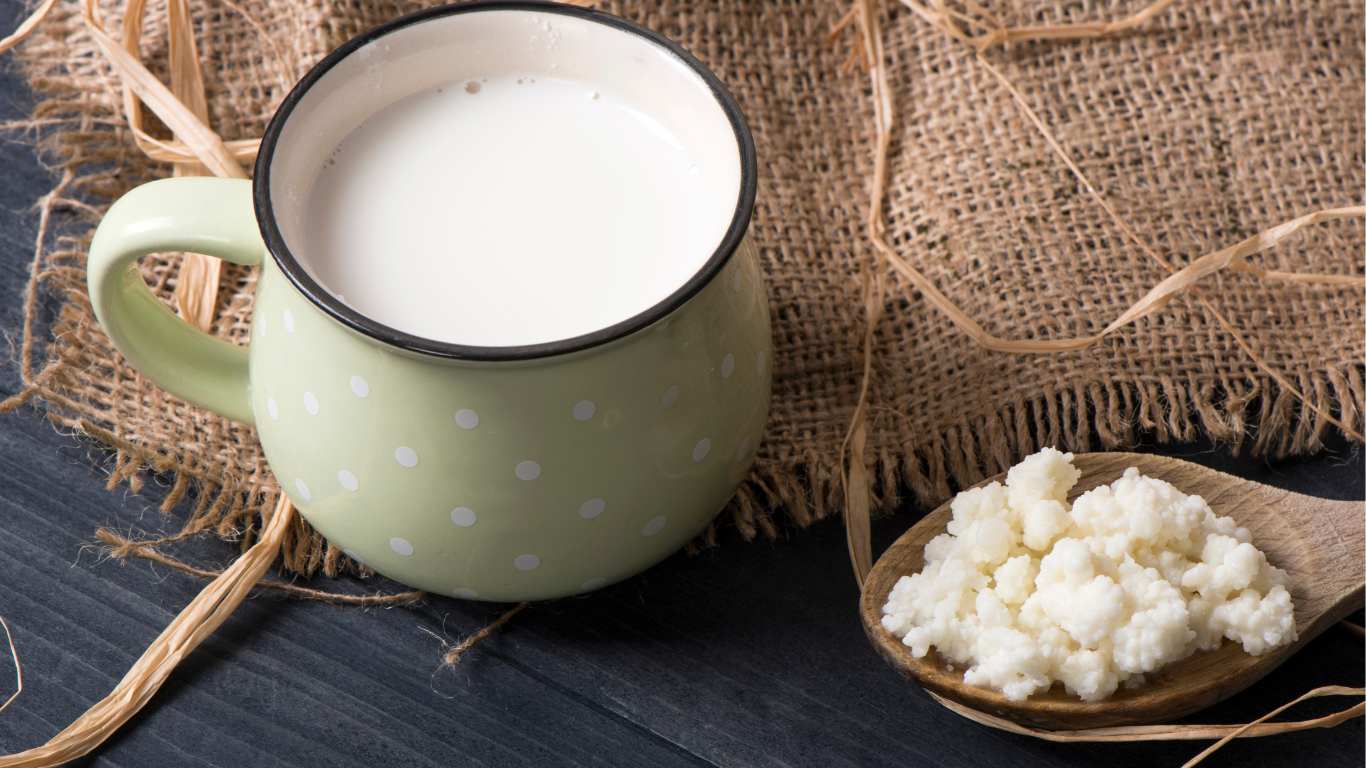Homemade kefir has become a beloved staple for health-conscious individuals seeking a flavorful boost to their well-being. It is often a simple yet rewarding process of making kefir from kefir grains. But for many home cooks and beginners, a common question remains- how can we make kefir from kefir grains?
To make kefir, you need to mix kefir grains with milk in a glass jar and leave it in sunlight for 12 to 48 hours to ferment. After that, just straining the mixture will leave you with homemade kefir. It’s that simple.
Today, the appeal of homemade kefir lies in its accessibility and customization. With just a few simple ingredients – kefir grains, milk, and a bit of patience – anyone can embark on a journey to create this at home. In this article, we will uncover the bits and pieces of making kefir from kefir grains.

Can I Make My Own Kefir Grains From Scratch?
Yes, it is possible to make Kefir grains from scratch, but it is an elaborate process. These grains cannot be synthesized artificially. Instead, they are a product of centuries-old fermentation traditions, passed down through generations.
Kefir grains are unique symbiotic cultures of bacteria and yeast (SCOBY) that resemble small, gelatinous pearls. These grains cannot be synthesized artificially. Instead, they are a product of centuries-old fermentation traditions, passed down through generations. For beginners, making kefir grains from scratch can be a challenge, but with practice it is possible.
Creating kefir grains from scratch involves cultivating a diverse microbial formation that is capable of producing kefir. While it’s possible to achieve this, the success rate is highly unpredictable. Factors such as temperature, humidity, and airborne contaminants can influence the composition of the microbial community, leading to inconsistent results.
Can I Make Kefir Grains From Store Bought Kefir?
Yes, you can make kefir grains from store-bought kefir, although the process can be somewhat uncertain and may not always yield consistent results. Store-bought kefir typically contains live active cultures, which are essential for fermenting milk and producing kefir.
To create kefir grains from store-bought kefir, you can follow a process known as rehydration. This involves placing a small amount of store-bought kefir in a clean glass jar and allowing it to ferment at room temperature for several days. During this time, the live cultures present in the kefir may begin to multiply and form small, gelatinous particles – the beginnings of kefir grains.
However, it’s important to note that the success rate of this method can vary, and it may take several attempts before viable kefir grains develop. Additionally, the resulting grains may not possess the same stability as authentic kefir grains obtained from a reliable source.
So, while it’s possible to make kefir grains from store-bought kefir, the process can be very challenging. It is often more reliable to obtain kefir grains from a reputable supplier or propagate them from a trusted source.

How To Make Kefir With Kefir Grains?
Making kefir with kefir grains is a simple process that requires minimal ingredients and equipment. Whether you are a beginner or have a good experience in the kitchen, you can easily make kefir with kefir grains. Here are some simple steps to help you make kefir.
Prepare Your Ingredients and Equipment
Begin by assembling all the necessary items for making kefir with kefir grains. You’ll need kefir grains, milk (cow’s milk, goat’s milk, or non-dairy alternatives like coconut milk), a glass jar, a non-metal stirring utensil, and a breathable cloth or coffee filter.
It’s crucial to ensure that everything is meticulously clean to prevent any unwanted contaminants from interfering with the fermentation process. Cleaning your utensils and containers thoroughly beforehand helps maintain the integrity of the fermentation. This ensures the production of high-quality kefir.
Combine Kefir Grains and Milk
Once you have all your ingredients and equipment ready, it’s time to combine the kefir grains with the milk. Pour the desired amount of milk into the glass jar, leaving some space at the top to accommodate any expansion during fermentation. The next step involves adding the kefir grains to the milk. Generally, a ratio of approximately 1 tablespoon of kefir grains per 1-2 cups of milk works well.
These kefir grains act as the catalyst for fermentation, kickstarting the process by metabolizing the lactose present in the milk and converting it into lactic acid. This conversion is what gives kefir its characteristic tangy flavor and creamy texture.
Ferment the Mixture
With the kefir grains and milk combined in the glass jar, cover the jar with a breathable cloth or coffee filter. Secure the cover with a rubber band or string to prevent any insects or contaminants from getting into the mixture while still allowing air circulation.
The fermentation process occurs most effectively in a warm, dark environment away from direct sunlight. Place the jar in a suitable spot and allow the mixture to ferment for a period of 12 to 48 hours, depending on your desired level of tanginess and thickness.
Longer fermentation times result in a tangier and thicker kefir. During this time, the kefir grains work their magic, transforming the milk into a nutritious and delicious probiotic beverage.
Strain the Kefir and Enjoy
After the fermentation period is complete and your kefir has reached the desired level of tanginess and consistency, it’s time to strain out the kefir grains from the liquid. Using a fine mesh sieve or strainer, carefully separate the kefir grains from the kefir liquid.
It’s essential to handle the grains gently to avoid damaging them. Once separated, you can proceed to the next step while ensuring that you save the kefir grains for future batches. With the kefir grains removed, you can now transfer the strained kefir liquid into a clean glass container for storage.
Keep the strained kefir in your fridge so that it doesn’t spoil. It should stay fresh for about 7 to 10 days. This is important as kefir being a milk product can go bad really quickly under room temperature.

Where Do Kefir Grains Come From?
Kefir grains trace their origins to the rugged and mountainous terrain of the North Caucasus. Folklore suggests that these remarkable grains were stumbled upon by local shepherds who noticed the transformative effects they had on milk left in leather pouches.
Milk kefir boasts an extensive history, dating back thousands of years, with its earliest traces discovered within a 4,000-year-old tomb located in China’s Xiohe region. This indicates that kefir was a staple in the diets of ancient civilizations. Throughout history, kefir has been highly valued and consumed by various cultures worldwide.
Historians attribute the preservation and dissemination of milk kefir to its significant role among the peoples of the North Caucasus. Over 2,000 years ago, this region, situated between Russia and Georgia, was inhabited by nomadic mountain communities who relied on herds of goats and cattle for milk production. This traces back to the history and the origin of Kefir grains.
Conclusion
Making kefir from kefir grains is a rewarding and enjoyable process that allows you to harness the benefits of probiotics while enhancing your culinary creativity. So, in this way, with the right tools and guidelines we can make kefir from kefir grains easily.
Thanks for stopping by. And I hope that this article was able to help you make some yummy kefir all by yourself.



